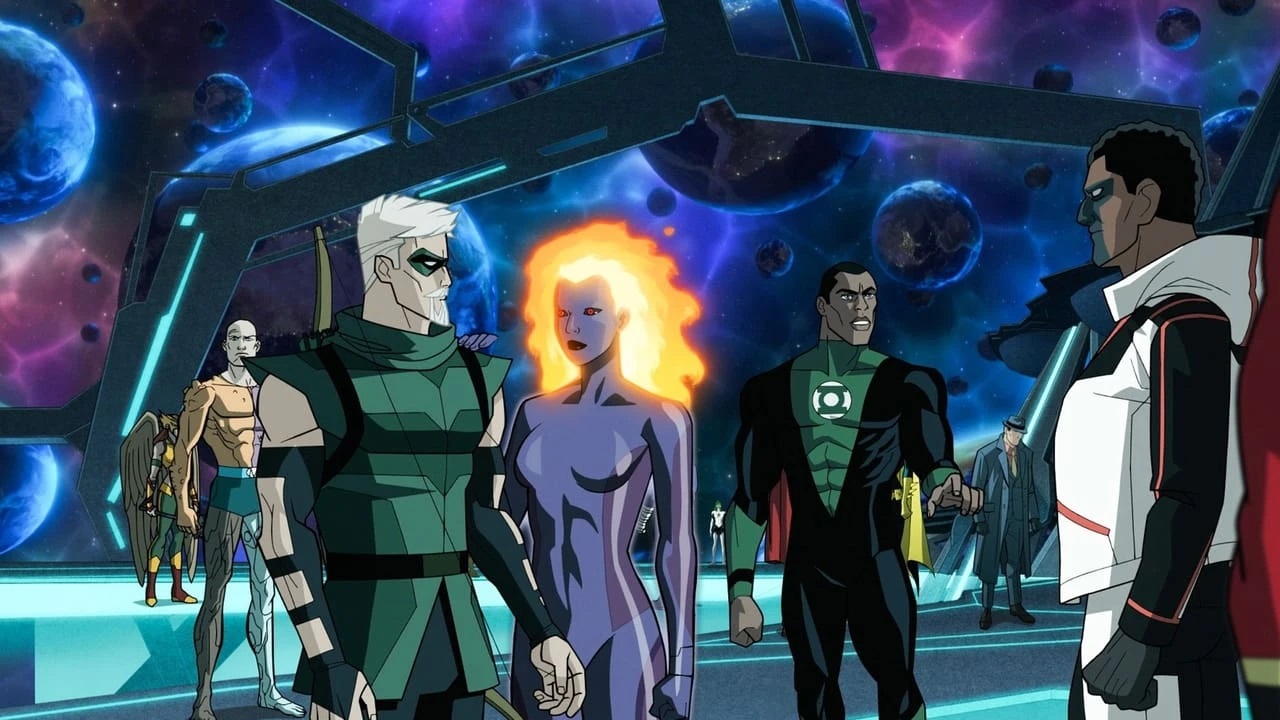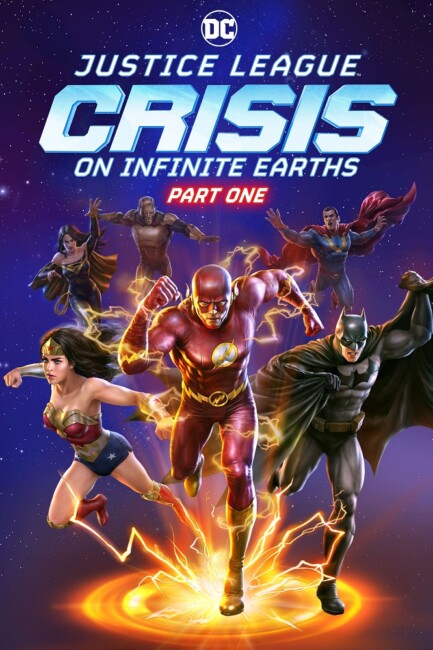USA. 2024.
Crew
Director – Jeff Wamester, Screenplay – Jim Krieg, Based on the Graphic Novel Crisis on Infinite Earths (1985-6) by George Perez & Marv Wolfman, Producers – Jim Krieg & Kimberly S. Moreau, Music – Kevin Riepl, Animation Directors – Youngsoo Kim, Hanhyung Lee & Sungchan Lee, Animation – Edge Animation., Ltd (Supervising Director – Junsik Cho, Animation Directors – Dongman Kim, Jonggeun Lee & Yeongdon Lee). Production Company – Warner Bros. Animation.
Voices
Matt Bomer (The Flash/Barry Allen), Jensen Ackles (Batman/Bruce Wayne), Darren Criss (Superman/Earth-2 Superman), Ashleigh Lathorp (Iris West), Nolan North (Amazo/Green Lantern/Homeless Man), Jonathan Adams (Monitor), Meg Donnelly (Supergirl/Harbinger), Zachary Quinto (Lex Luthor), Ike Amadi (J’onn J’onnz/Professor Anthony Ivo/Amazing Man), Stana Katic (Wonder Woman/Superwoman), Jimmi Simpson (Green Arrow), Erika Ishi (Dr Light/Dr Hoshi, Huntress), Cynthia Hamidi (Dawnstar), Aldis Hodge (Power Ring/John Stewart), David Kaye (The Question), Geoffrey Arend (Psycho Pirate/Hawkman), Liam McIntyre (Aquaman/Johnny Quick), Zach Callison (Dick Grayson/Robin), Lou Diamond Phillips (The Spectre/Owlman), Harry Shum Jr. (Brainiac 5), Keesha Sharp (Vixen), Matt Lanter (Blue Beetle/Ultraman), Alistair Duncan (Alfred Pennyworth), Ato Essandoh (Mr Terrific), Alexandra Daddario (Lois Lane)
Plot
The Flash is joined by Superman and Green Arrow as they fight against Amazo, an android created by a Lex Luthor associate that can absorb the powers of superheroes. To deal with the threat, Green Arrow introduces the others to Bruce Wayne and reveals he is Batman. Together they recruit other superpowered beings and form the Justice League. The Flash is able to use the Speed Force to travel between different worlds of the multiverse, encountering other versions of himself and the Justice League. He then meets Monitor, one of an ancient race of aliens that has been observing the universe since the beginning of time. Monitor has broken with his code to not intervene and has brought a line-up of different heroes together to deal with a dire threat – an anti-matter wave that is moving through the various universes of the multiverse obliterating everything in its path.
Crisis on Infinite Earths (1985-6) was a comic-book mini-series released for the fiftieth anniversary of DC Comics. Writer Marv Wolfman set out with the intention of harmonising the complicated multiverse that DC had created, including alternate universes where Silver Age characters remain in a permanent WWII setting, others where the villains are heroes and so on. The series wiped out all the other universes and brought everything together into a single universe, while eliminating a number of characters from continuity including Supergirl and the Barry Allen version of The Flash. The results were hugely successful and followed by DC rebooting most of the characters to adhere to the new continuity.
There have been assorted follow-ups to this with Infinite Crisis (2005–2006), Final Crisis (2008–2009) and Dark Crisis on Infinite Earths (2022). The series was previously adapted to the screen (loosely) in the Arrowverse’s Crisis on Infinite Earths (2020), a five-episode arc stretched out between the various series Arrow, The Flash, Supergirl, Batwoman and Legends of Tomorrow, and reuniting all the central and numerous others who had appeared in guest parts, along with a number of actors from other DC media creations (Burt Ward, Kevin Conroy, Brandon Routh).
This was another film among the DC Original Animated Movies. It comes alongside Superman: Doomsday (2007), Batman: Gotham Knight (2008), Justice League: The New Frontier (2008), Green Lantern: First Flight (2009), Superman/Batman: Public Enemies (2009), Wonder Woman (2009), Batman: Under the Red Hood (2010), Justice League: Crisis on Two Earths (2010), Superman & Batman: Apocalypse (2010), All-Star Superman (2011), Batman: Year One (2011), Green Lantern: Emerald Knights (2011), Batman: The Dark Knight Returns Part I (2012), Justice League: Doom (2012), Superman vs. The Elite (2012), Batman: The Dark Knight Returns Part II (2013), Justice League: The Flashpoint Paradox (2013), Superman Unbound (2013), Batman: Assault on Arkham (2014), Justice League: War (2014), Son of Batman (2014), Batman vs. Robin (2015), Justice League: Gods and Monsters (2015), Justice League: Throne of Atlantis (2015), Batman: Bad Blood (2016), Batman: The Killing Joke (2016), Justice League vs Teen Titans (2016), Batman and Harley Quinn (2017), Justice League Dark (2017), Teen Titans: The Judas Contract (2017), Batman: Gotham By Gaslight (2018), The Death of Superman (2018), Suicide Squad: Hell to Pay (2018), Batman: Hush (2019), Justice League vs The Fatal Five (2019), Reign of the Supermen (2019), Wonder Woman: Bloodlines (2019), Justice League Dark: Apokolips War (2020), Superman: Man of Tomorrow (2020), Superman: Red Son (2020), Batman: Soul of the Dragon (2021), Batman: The Long Halloween Part One (2021), Batman: The Long Halloween Part Two (2021), Injustice (2021), Justice Society: World War II (2021), Batman and Superman: Battle of the Super Sons (2022), Catwoman: Hunted (2022), Batman: The Doom That Came to Gotham (2023), Green Lantern: Beware My Power (2022), Justice League: Warworld (2023), Legion of Super-Heroes (2023), Watchmen: Chapter I (2024) and Watchmen: Chapter II (2024).
The multiverse theme has suddenly been popular on films ever since Spider-Man: Into the Spider-Verse (2018) and since then has appeared in a surprising number of other superhero films including Spider-Man: No Way Home (2021), The MCU’s Doctor Strange in the Multiverse of Madness (2022), Ant-Man and the Wasp: Quantumania (2023), Deadpool & Wolverine (2024) and by the DCEU in The Flash (2023). (For a more detailed listing see Alternate Timelines and Multiverses). Now would seem to be the opportune time for taking on an adaptation of Crisis on Infinite Earths.

Warner Bros. Animation have decided to make an epic out of Crisis on Infinite Earths. A number of previous films such as The Dark Knight Returns, The Death of Superman and The Long Halloween have been initially released in two parts and combined as one film subsequently. In an unprecedented move, Crisis on Infinite Earths is to be released in three different parts of which this is the first – this may well either reflect the stature of the original story or its epic scope, which was spread over twelve different issues and referenced in more than a dozen other ongoing titles. To follow would be Justice League: Crisis on Infinite Earths Part Two (2024) and Justice League: Crisis on Infinite Earths Part Three (2024).
It is worth noting as Crisis on Infinite Earths Part One starts that it is only the first chapter of a preplanned saga. Thus it is little more than an introduction to Monitor and the threat the multiverse is facing. It is interesting seeing the large panoply of superheroes introduced. This does become a clever opportunity for us to revisit the world of Crisis on Two Earths, which offered an alternate world where the members of the Justice League were all villains.
Some of Crisis on Infinite Earths Part One left me confused. I wasn’t quite sure what the scenes involving an aged version of The Flash and Iris were about as they don’t seem connected to the story. The film does also take time out to give us scenes at the start with the creation of the Justice League – I wasn’t quite sure about the purpose of these as they were not part of the original graphic novel and it is unclear why they had to be boiler-plated on here. (There is also egregious lack of any Wonder Woman involved in the creation of the Justice League and her puzzling replacement by the character of Vixen, not a character that has even appeared in the DCEAU before).
I thought Crisis on Infinite Earths Part One was okay. It does what it was meant to, which is introduce Monitor and the threat facing the multiverse. There is some okay superheroic action, although it is not quite as epic as it used to be in the DCEAU’s heyday – Jeff Wamester is a new rising director in this regard but I still preferred the work of someone like Lauren Montgomery. Does Crisis on Infinite Earths Part One have the quality that does service to a classic storyline? Not quite but this is only the first part of three. Still it is better than the big letdown that was Jeff Wamester’s previous film Justice League: Warworld.
Trailer here


